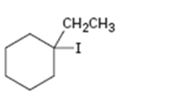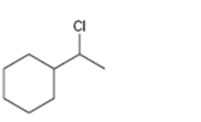
Concept explainers
a)

Interpretation:
The alkene that will give 1-bromocyclopentane in an addition reaction is to be identified.
Concept introduction:
In addition reactions small molecules like HCl, H2O, HBr etc. add to the double bond in an alkene to yield a single product. The addition to unsymmetrical
To state:
Which alkene will give 1-bromocyclopentane as product in an addition reaction.
b)

Interpretation:
The alkene that will give 1-ethyl-1-iodocyclopentane in an addition reaction is to be identified.
Concept introduction:
In addition reactions small molecules like HCl, H2O, HBr etc. add to the double bond in an alkene to yield a single product. The addition to unsymmetrical alkenes will follow Markovnikov’s rule which states that “in the addition of HX to an alkene, the H adds to the carbon with fewer alkyl substituents and X adds to the carbon with more alkyl substituents”.
To state:
Which alkene will give 1-ethyl-1-iodocyclohexane as product in an addition reaction.
c)

Interpretation:
The alkene that will give 3-bromohexane in an addition reaction is to be identified.
Concept introduction:
In addition reactions small molecules like HCl, H2O, HBr etc. add to the double bond in an alkene to yield a single product. The addition to unsymmetrical alkenes will follow Markovnikov’s rule which states that “in the addition of HX to an alkene, the H adds to the carbon with fewer alkyl substituents and X adds to the carbon with more alkyl substituents”.
To state:
Which alkene will give 3-bromohexane as product in an addition reaction.
d)

Interpretation:
The alkene that will give 1-chloroethylcyclopentane in an addition reaction is to be identified.
Concept introduction:
In addition reactions small molecules like HCl, H2O, HBr etc. add to the double bond in an alkene to yield a single product. The addition to unsymmetrical alkenes will follow Markovnikov’s rule which states that “in the addition of HX to an alkene, the H adds to the carbon with fewer alkyl substituents and X adds to the carbon with more alkyl substituents”.
To state:
Which alkene will give 1-chloroethylcyclohexane as product in an addition reaction.
Trending nowThis is a popular solution!

Chapter 7 Solutions
Study Guide with Student Solutions Manual for McMurry's Organic Chemistry, 9th
- Predict the major products of this organic reaction. If there aren't any products, because nothing will happen, check the box under the drawing area instead. D ㄖˋ ید H No reaction. + 5 H₂O.* Click and drag to start drawing a structure. OH H₂Oarrow_forwardDraw one product of an elimination reaction between the molecules below. Note: There may be several correct answers. You only need to draw one of them. You do not need to draw any of the side products of the reaction 'O 10 + x 也 HO + 义 Click and drag to start drawing a structure.arrow_forwardWhat are the angles a and b in the actual molecule of which this is a Lewis structure? H- :0: C=N: b Note for advanced students: give the ideal angles, and don't worry about small differences from the ideal that might be caused by the fact that different electron groups may have slightly different sizes. a = 0° b=0 Xarrow_forward
- A student proposes the transformation below in one step of an organic synthesis. There may be one or more products missing from the right-hand side, but there are no reagents missing from the left-hand side. There may also be catalysts, small inorganic reagents, and other important reaction conditions missing from the arrow. • Is the student's transformation possible? If not, check the box under the drawing area. • If the student's transformation is possible, then complete the reaction by adding any missing products to the right-hand side, and adding required catalysts, inorganic reagents, or other important reaction conditions above and below the arrow. • You do not need to balance the reaction, but be sure every important organic reactant or product is shown. + This transformation can't be done in one step. T iarrow_forwardDetermine the structures of the missing organic molecules in the following reaction: H+ O OH H+ + H₂O ☑ ☑ Note: Molecules that share the same letter have the exact same structure. In the drawing area below, draw the skeletal ("line") structure of the missing organic molecule X. Molecule X shows up in multiple steps, but you only have to draw its structure once. Click and drag to start drawing a structure. X § ©arrow_forwardTable 1.1 Stock Standard Solutions Preparation. The amounts shown should be dissolved in 100 mL. Millipore water. Calculate the corresponding anion concentrations based on the actual weights of the reagents. Anion Amount of reagent (g) Anion Concentration (mg/L) 0.1649 Reagent Chloride NaCl Fluoride NaF 0.2210 Bromide NaBr 0.1288 Nitrate NaNO3 0.1371 Nitrite NaNO2 0.1500 Phosphate KH2PO4 0.1433 Sulfate K2SO4 0.1814arrow_forward
- Draw the structure of the pound in the provided CO as a 300-1200 37(2), 11 ( 110, and 2.5 (20arrow_forwardPlease help me with # 4 and 5. Thanks in advance!arrow_forwardA small artisanal cheesemaker is testing the acidity of their milk before it coagulates. During fermentation, bacteria produce lactic acid (K₁ = 1.4 x 104), a weak acid that helps to curdle the milk and develop flavor. The cheesemaker has measured that the developing mixture contains lactic acid at an initial concentration of 0.025 M. Your task is to calculate the pH of this mixture and determine whether it meets the required acidity for proper cheese development. To achieve the best flavor, texture and reduce/control microbial growth, the pH range needs to be between pH 4.6 and 5.0. Assumptions: Lactic acid is a monoprotic acid H H :0:0: H-C-C H :0: O-H Figure 1: Lewis Structure for Lactic Acid For simplicity, you can use the generic formula HA to represent the acid You can assume lactic acid dissociation is in water as milk is mostly water. Temperature is 25°C 1. Write the K, expression for the dissociation of lactic acid in the space provided. Do not forget to include state symbols.…arrow_forward
- Curved arrows are used to illustrate the flow of electrons. Using the provided starting and product structures, draw the curved electron-pushing arrows for the following reaction or mechanistic step(s). Be sure to account for all bond-breaking and bond-making steps. :0: :0 H. 0:0 :0: :6: S: :0: Select to Edit Arrows ::0 Select to Edit Arrows H :0: H :CI: Rotation Select to Edit Arrows H. < :0: :0: :0: S:arrow_forward3:48 PM Fri Apr 4 K Problem 4 of 10 Submit Curved arrows are used to illustrate the flow of electrons. Using the provided starting and product structures, draw the curved electron-pushing arrows for the following reaction or mechanistic step(s). Be sure to account for all bond-breaking and bond-making steps. Mg. :0: Select to Add Arrows :0: :Br: Mg :0: :0: Select to Add Arrows Mg. Br: :0: 0:0- Br -190 H 0:0 Select to Add Arrows Select to Add Arrows neutralizing workup H CH3arrow_forwardIarrow_forward
